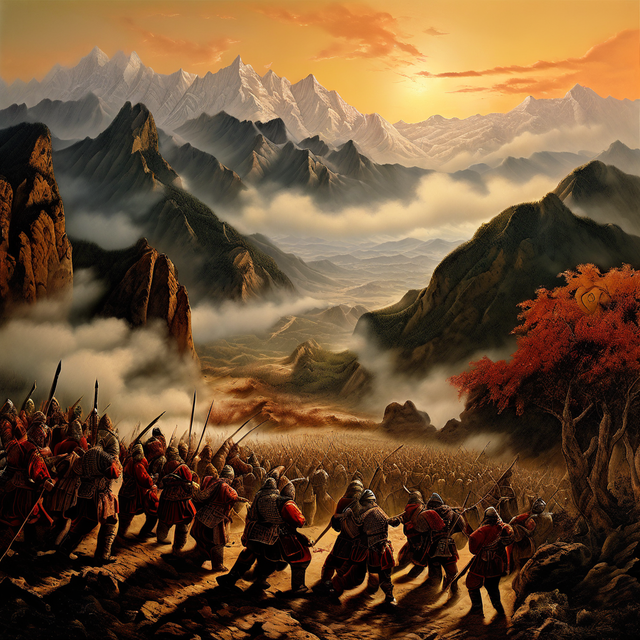地理优势如何塑造中国历史:从秦国到现代

昨天讲前天讲到了气候变化对中国历史的发展的影响。提到小冰期,对明、王七新以及五湖乱华这两次重大的历史变革所起到的重要作用。实体店是什么?而正像俗话所说的,欲成大事,必须占天时,地利人和。今天就再来讲讲地利地理因素也是影响历史演变得非常重要的因素。看中国古代的王朝兴衰史。嗯,是是这里就是哦哦拿出来开始来会发现一个很明显的规律,那就是一般都是关中地区统一关东的中原地区北方的黄河流域,统一南方的长江流域。而历史上,天安、江南朝中原大都也会发动北伐。比如南北朝时期的刘宋以及宋金时期的南宋。但是这些北伐能够取得彻底胜利的,几乎没有。除了朱元璋建立明朝的过程以外,造成这一现象的原因就是东亚地区的地形因素起到了很大的作用。而地形之所以会发挥如此巨大的作用,根本原因就是他对战争的成本造成了巨大的影响。先说先以秦战国时期的群雄争霸为例,战国七雄当中,一开始地处关中地区的秦国,无论在文化还是经济繁荣程度战至出身,都和东方六国差距很大。春秋时期的霸楚,晋国分裂出来的一个魏国都可以把秦国按在地上摩擦。如果真的有人穿越回古代告诉东方六国的君主战国这场大逃杀游戏,最后的胜利者是秦国,估计没有人会相起,为什么会如此?现在有的说法是,由于波斯帝国的崛起,波斯帝国和希希腊的亚历山大帝国相继崛起,他们的势力延伸到了中亚使后世文明的丝绸之路已经初具雏形,使得秦国和这些东亚以外的地区有了初步的接触和交流,引进了很多较为先进的生产技术和兵器制造技术,使得秦军在装备和战斗力方面有了很大的提升。那一说法在近来的考古上也找到了一些证据。比如在秦始皇陵的工匠墓学的发掘中,就发现有类似白种人的遗骨。而秦始皇兵马俑那种写实逼真的造型风格非常类似于希腊的雕塑艺术,而与汉朝初期那种夸张抽象的风格迥然不同。当然最重要的还是秦国的地理优势,那就是函谷关。如果东方六国要除掉秦国这个隐患,必须攻破函谷关才能进入关中地区,而韩国地形险要位于一个狭长的山谷当中。尽管以当时六国的实力进行合纵组成联盟是可以主持城规模,而数量远超秦国的军队。但是这样的规模优势,在函谷关的地形之下是发挥不出来的。正所谓一夫当关,万夫莫开。所以,六国攻打秦国,需要组织更庞大的军队,消耗更多的火行物资,而战国能取得的战国却非常有限,而秦国只需要付出很小的代价和成本,守住函谷关,就能够抵御住六国联军的进攻。而如果秦国采取攻势,秦军出函谷关之后,攻打东方六国的城池,而攻防六国基本上却没有像函谷关这样险要的防御地形要击退秦军的进攻,也要付出相当大的代价。所以,从这种地形造成的战争成本上的巨大差异,也不难得出秦国会最终胜出的结论。那为什么总是黄河流域的政权统一长江流域的政权呢?现在有些所谓的医学爱好者认为,黄河流域的政权一般都是由北方游牧民族南下建立的。这些游牧民族相对于文弱的南方游人,王朝武德更加充沛。其实这在很大的程度上,也是一个后勤与战争成本的问题。不管是古代战争,还是现代战争,决定战争胜负,最根本的因素,还是游勤能力,还是兵马未动,粮草先行。而古代战争,如果通过陆路进行后勤补给,损耗将是惊人的粗略,估计要供养前线的一个士兵,需要至少三个民夫为其运粮提供后勤补给,而将一旦的粮食运送到前线,因为负责运输的民夫和牲口也需要粮草,所以大概需要损耗三担的粮四担的粮食,这也是汉武帝北征匈奴搞得天下户口减半的主要原因。好,今天先说到这里。
The day before yesterday, I talked about the impact of climate change on the development of Chinese history. The Little Ice Age played an important role in the two major historical changes of Ming, Wang Qixin and Five Lakes. What is a physical store? And as the saying goes, to achieve great things, you must occupy the right time, the right place and the right people. Today, I will talk about geographical factors are also very important factors affecting the historical evolution. Look at the history of the rise and fall of dynasties in ancient China. Well, yes, here is oh oh take it out and you will find a very obvious rule, that is, generally the Guanzhong area is unified in the Central plains of the Guandong, the Yellow River basin in the north, and the Yangtze River basin in the south. Historically, Tianan and Jiangnan Dynasties in the Central Plains would also launch northern expeditions. For example, the Liu Song in the Southern and Northern Dynasties and the Southern Song in the Song and Jin Dynasties. But few of these northern expeditions were ever completely successful. In addition to the process of Zhu Yuanzhang's establishment of the Ming Dynasty, the reason for this phenomenon is that the topographic factors in East Asia played a large role. The fundamental reason why terrain plays such a huge role is that it has a huge impact on the cost of war. First of all, take the Warring States period of the Qin Dynasty as an example. Among the seven Warring States, Qin, which was located in the Guanzhong region at the beginning, had a big gap with the Eastern six States in terms of culture and economic prosperity. During the Spring and Autumn Period, the state of Chu and the State of Wei, which was split from the State of Jin, could press the state of Qin to the ground and rub against it. If someone really traveled back to ancient times and told the Kings of the six Eastern States that the battle of the Warring States was a great battle and the final winner was the State of Qin, it is estimated that no one would react. Why would that be? Some people now say that with the rise of the Persian Empire and the rise of the Persian Empire and the Empire of Alexander in Greece, their influence extended to Central Asia and the Silk Road of later civilization took shape. Qin had initial contact and exchanges with these regions outside East Asia and introduced a lot of relatively advanced production technology and armaments manufacturing technology. The Qin Army has been greatly improved in terms of equipment and combat effectiveness. There is some evidence for that theory in recent archaeology. For example, in the excavation of artisan tomb science in the mausoleum of the First Emperor of Qin, it was found that there were similar bones of Caucasians. The realistic style of the Terracotta Warriors and horses is very similar to the sculpture art of Greece, and it is completely different from the exaggerated and abstract style of the early Han Dynasty. Of course, the most important is the geographical advantage of Qin, that is, the Hangu Pass. If the six Eastern States want to get rid of the hidden danger of Qin, they must break the Hangu Pass to enter the Guanzhong area, and the terrain of Korea is very dangerous in a narrow valley. Although with the strength of the six states at that time, the alliance could dominate the size of the city, and the number of Qin's army was far greater. However, such scale advantages cannot be played out under the terrain of Hangu Pass. As the saying goes, a man can't open a door. Therefore, to attack the state of Qin, the six States needed to organize a larger army and consume more fire-fighting materials, while the Warring States could obtain very limited warring States, and Qin only needed to pay a small price and cost to hold the Hangu Pass, so that it could resist the attack of the allied forces of the six States. However, if Qin takes an offensive, the Qin army will attack the cities of the six eastern States after leaving the Hangu Pass, while the six States basically have no such dangerous defensive terrain as the Hangu Pass, and it will be costly to repel Qin's attack. Therefore, from the huge difference in war costs caused by this terrain, it is not difficult to conclude that Qin will eventually win. So why is it always the Yellow River and the Yangtze River? Now, some so-called medical enthusiasts believe that political power in the Yellow River basin was generally established by northern nomads moving south. These nomads had more imperial martial arts than the milder southern travelers. To a large extent, this is also a question of logistics and war costs. Whether it is ancient war, or modern war, the most fundamental factor to determine the outcome of the war, or the ability to swim, or the troops and horses have not moved, food and grass first. In ancient wars, if logistics supplies were carried out by land, the losses would be surprisingly rough. It is estimated that to support a soldier at the front line, at least three civilian men would be required to provide logistics supplies for his grain transport. To transport the grain to the front line, because the civilian men and livestock responsible for transportation also need grain and grass, about three truckloads of grain and four truckloads of grain would be lost. This is also the main reason why Emperor Wudi's northern conquest of Hungary made the world account halved. Okay, that's all for today.
Upvoted! Thank you for supporting witness @jswit.
喜欢看,建议分段版面更舒适些